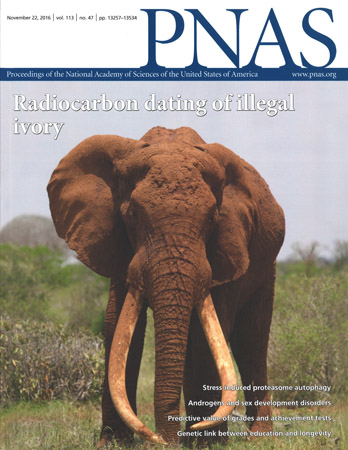
Biology Under Cover
Selected Journal & Book Covers from SBS Faculty
“Radiocarbon dating of seized ivory confirms rapid decline in African elephant populations and provides insight into illegal trade”
Thure Cerling, Janet Barnette, Lesley Chesson, Iain Douglas-Hamilton, Kathleen Gobush, Kevin Uno, Samuel Wasser, and Xiaomei Xu
Commentary
Carbon-14 measurements on 231 elephant ivory specimens from 14 large ivory seizures (≥0.5 ton) made between 2002 and 2014 show that most ivory (ca. 90%) was derived from animals that had died less than 3 years before ivory was confiscated. This indicates that the assumption of recent elephant death for mortality estimates of African elephants is correct: Very little “old” ivory is included in large ivory shipments from Africa and almost all ivory seized by customs officials is from animals killed very recently. We found only one specimen of the 231 analyzed to have a lag time longer than 6 years. Patterns of trade differ by regions: East African ivory, based on genetic assignments of geographic origin, has a much higher fraction of “rapid” transit than ivory originating in the Tridom region of Cameroon–Gabon–Congo. Carbon-14 is an important tool in understanding patterns of movement of illegal wildlife products. This image is of Satao, one of the largest “Big Tuskers” of the Tsavo National Park in Kenya. Shortly after this picture was taken, he was killed by poachers for his ivory.
Abstract
Carbon-14 measurements on 231 elephant ivory specimens from 14 large ivory seizures (≥0.5 ton) made between 2002 and 2014 show that most ivory (ca. 90%) was derived from animals that had died less than 3 y before ivory was confiscated. This indicates that the assumption of recent elephant death for mortality estimates of African elephants is correct: Very little “old” ivory is included in large ivory shipments from Africa. We found only one specimen of the 231 analyzed to have a lag time longer than 6 y. Patterns of trade differ by regions: East African ivory, based on genetic assignments of geographic origin, has a much higher fraction of “rapid” transit than ivory originating in the Tridom region of Cameroon–Gabon–Congo. Carbon-14 is an important tool in understanding patterns of movement of illegal wildlife products.
